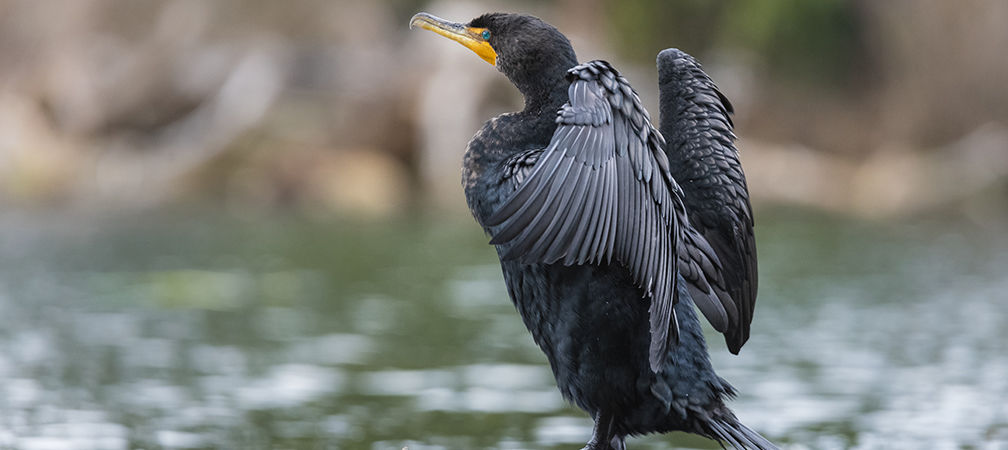Ontario Nature Blog
Receive email alerts about breaking conservation
and environmental news.
© Lora Denis
Cormorant © Kerrie Blaise
This article was originally published by The Lawyer’s Daily (www.thelawyersdaily.ca), part of LexisNexis Canada Inc.
(September 22, 2020, 11:07 AM EDT) — Ontario has recently moved forward with amendments to its fish and wildlife laws, permitting a new 106-day open season on the double crested cormorant, a water bird native to Ontario. As of Sept. 15, 2020, hunters are permitted to bag 15 birds per day as part of Ontario’s “population management tool” in response to concerns that the birds may be been detrimental to fish populations and aesthetics.
Rebuked by conservation ecologists and experts for the lack of scientific justification, the hunt poses three distinct legal ramifications, each representing a significant departure from Ontario and Canada’s wildlife laws and best practices.
First, the Ontario’s Fish and Wildlife Conservation Act (FWCA) prohibits having a loaded firearm in a motorboat. However, amendments to the Act’s regulations now permit those hunting cormorants to use a shotgun (of not more than 10 gauge) from a stationary motorboat. This is a notable departure from recognized wildlife management principles that wherever possible, human activities should be managed to avoid or minimize conflicts with wild animals. The potential for human-wildlife conflict in this instance is high, as cormorants nest in areas which are also popular cottage, camping and paddling destinations.
Second, the hunt originates with the Ministry of Natural Resources and Forestry (MNRF), who is mandated with sustainably managing Ontario’s fish and wildlife resources. However, as noted in an open letter to the MNRF penned by many conservation biologists and fisheries scientists, the province has not provided any scientifically backed rationale for why a provincewide hunt is necessary instead of more localized or targeted management approaches.
While the hunt was announced on the basis it would “protect fish stocks and natural habitat from the harmful impacts of double-crested cormorants,” the amendments have not established mechanisms for monitoring whether the purported benefits to potentially preyed upon fish populations will be achieved. Of equal concern, the province has not set population objectives for cormorants, thus providing no safeguards for a minimum population level. As the signatories to the open letter illustrate, the estimated breeding population of cormorants in Ontario could be extinguished if 0.5 per cent of all small game hunters were to reach the daily 15 cormorants per day bag limit for just 10 of the allowable 106-day hunt.
Third, the joint Canada-US Migratory Bird Convention Act, 1994 (MBCA) prohibits the hunting of migratory birds and destruction to their nest sites or habitat. While cormorants are not among the birds protected under the Act, Ontario’s provincial bird — the common loon — as well as the neotropic cormorant, and anhinga are, and due to their similar appearance may experience collateral harm from the cormorant hunt. Unless a hunter has the requisite permits to hunt or harm a migratory bird, incidental killing of listed migratory birds would be a violation of the MBCA. Further, while the MBCA requires permit holders to report the number of birds killed, equivalent reporting requirements do not exist in the FWCA and nor were they incorporated as part of the changes to Ontario’s wildlife regulations.

For many Ontarians, observing cormorants in numbers often in the hundreds or thousands is viewed as alarming or unnatural and legitimates the need for the hunt. However, cormorants by nature nest in colonies thousands of pairs strong, typically on islands and usually on big lakes. Localized concentrations of cormorants and guano from nests can smother and kill the understory vegetation. However, the death of trees in cormorant colonies is a natural process and is part of the ecology which contributes to the biodiversity of the Great Lakes inshore region.
It must also be recalled that cormorants were nearly extinct in the 1970s, due to widespread culling which commenced in the 1950s and subsequent eggshell thinning, caused by persistent organic pollutants like DDT. The corresponding loss of large predatory fish in the Great Lakes and inland lakes because of overfishing and pollution also increased the levels of smaller fish such as alewife, the cormorant’s favoured food source.
Proceeding with a hunt under the guise of protecting fisheries or fish populations distracts us from the primary threats to our Great Lakes and inland lake ecosystems, which remains habitat degradation and invasive species. It also undermines the legitimacy of our wildlife laws, as the cormorant hunt signals the province’s willingness to enact regulatory changes based on perceptions of harm and not scientific bases. The recovery of a once near-extinct species should be a celebrated as a conservation success story. Instead, the cormorant hunt is the most recent indication that our laws aimed at wildlife and environmental protection do not have at their core, ecologically justified and transparent rationales which further sustainability.

Gananoque Lake Nature Reserve © Smera Sukumar
Doug Ford is destroying Ontario’s wildlife bit by bit. Thanks for your work.
Although there may be some issues regarding the use of boats in this management plan, the overall intent is sound.Cormorants like many species , engender differing responses across the population to their presence.
At the young age of 71, I have watched the rise of the population in areas around Kingston Ontario and in particular their destruction of vegetation on islands fronting Kingston and the St Lawrence. The concerns were raised many years ago of their return and growing numbers.
Since those early days they have moved into inland lakes creating the same issues and concerns.Denuded islands , depreciated property values and unsightly vistas are now commonplace. Fish species being consumed ? They do eat their share. In the absence of invasives , they will consume sport fish.The natural environment, habitat to many species is being challenged on many fronts. We seem to be unable to agree upon a cohesive plan nationally to confront the largest challenges but we can manage out of control populations provincially.The reaction generally to this « hunt » is more a reaction to hunting. Realistically, most hunters duck or otherwise will not waste their time chasing cormorants in boats across inland waters. Cottagers, home owners and lake front dwellers will though have an opportunity to deal with the cormorant on their property. The population of cormorants will be reduced not eliminated. There are too many more pressing environmental challenges that require greater attention. This is not one of them.
Hi John, cormorant researcher and professor Gail Fraser asserts that if 0.5% of small game hunters reached the daily hunt limit for ten days (15 cormorants per day), that would exceed the estimated breeding population in Ontario. So, this hunt is a pressing environmental challenge threatening a native species. For site specific concerns, non-lethal management strategies could be utilized, such as egg oiling. You can find more useful information on this issue in the resources listed above, as well as this webinar: https://www.crowdcast.io/e/tplcormorants
– ON Melina
Nature is under attack !
This is a VENDETTA !
THIS MUST STOP !
I believe that Ontario should follow science based information in its decisions to limit the Double Crested Cormorant hunt. This is not the case. ‘Rebuked by conservation ecologists and experts for the lack of scientific justification, the hunt poses three distinct legal ramifications, each representing a significant departure from Ontario and Canada’s wildlife laws and best practices.’
Please stop the hunt on a once endangered native bird of Ontario.